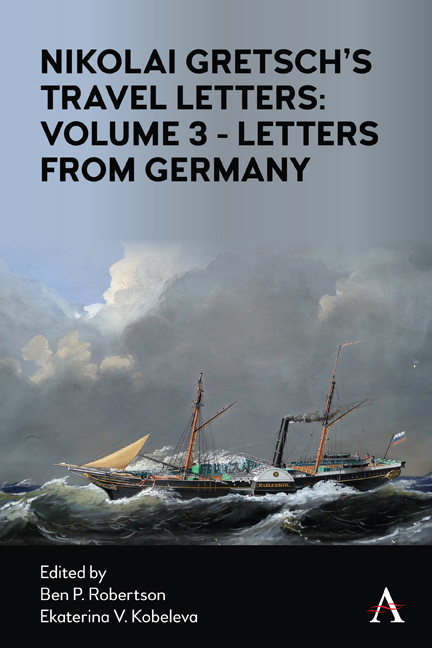Book contents
- Frontmatter
- Contents
- List of Illustrations
- Abbreviations
- Miscellaneous Frontmatter
- Introduction to Volume 3
- Letter XXXI
- Letter XXXII
- Letter XXXIII
- Letter XXXIV
- Letter XXXV
- Letter XXXVI
- Letter XXXVII
- Letter XXXVIII
- Letter XXXIX
- Letter XL
- Letter XLI
- Notes on this Translation
- Selected Bibliography
- Index
Letter XXXIV
Published online by Cambridge University Press: 22 October 2021
- Frontmatter
- Contents
- List of Illustrations
- Abbreviations
- Miscellaneous Frontmatter
- Introduction to Volume 3
- Letter XXXI
- Letter XXXII
- Letter XXXIII
- Letter XXXIV
- Letter XXXV
- Letter XXXVI
- Letter XXXVII
- Letter XXXVIII
- Letter XXXIX
- Letter XL
- Letter XLI
- Notes on this Translation
- Selected Bibliography
- Index
Summary
The Pinakothek. Basilica. Church of St. Ludwig. Church of All Saints. Church of Our Dear Lady. Church of St. Michael. Monument of Prince Eugene. Theatine Church. Churches of St. Mary and St. Salvator. Royal Palace. Court Garden. Arches. Isarthor. Paintings on glass. Monuments. English Garden. Research and educational institutions. University. Academy of Sciences and Art.
Another noteworthy temple of fine arts in Munich is the Pinakothek, or simply, the picture gallery (see Figure 3.7, The Pinakothek). The museum building, original and magnificent, is located not far from the Glyptothek. The design for this project was completed in the year 1823, under the late King Maximilian, but the construction works began under the present king on the 7th of April 1826, on the birthday of Raphael. The building is shaped as a parallelogram that runs from east to west. On the lower level are furnaces from which heat is dispersed through pipes. The rooms run in three parallel rows: in the middle are seven huge halls illuminated by skylights; along the northern side are twenty-three smaller rooms, or studies; along the southern side stretches a gallery divided into twenty-five sections. In addition, there are two separate halls on the western side, and one on the eastern; the latter is for the renovation (restoration) of paintings.
The entrance is magnificent. Portraits of the sovereigns who collected the treasures of fine art displayed in this museum adorn the huge antechamber: Here, we see Kurfürsts Johann Wilhelm, Maximilian Emanuel, Charles, Charles Theodore; Kings Maximilian and Ludwig. Next, one enters into the large halls decorated with sculptured, gilded ceilings and cornices. The walls are covered with red and green damask patterns. Skylights illuminate the space from above. The frames of the doors are made of grey marble. The paintings are exhibited on the walls with a proper observance of lighting. It seems to me, however, that in the Berlin Museum, where light falls on the paintings from the side, they are lighted better. Additionally, the Pinakothek's galleries are partitioned into several sections: This division interferes with the greatness of the whole but is convenient for a connoisseur.— The first two halls display paintings from the German School: Dürer, Cranach, Holbein, van Eyck, and others.
- Type
- Chapter
- Information
- Publisher: Anthem PressPrint publication year: 2021

